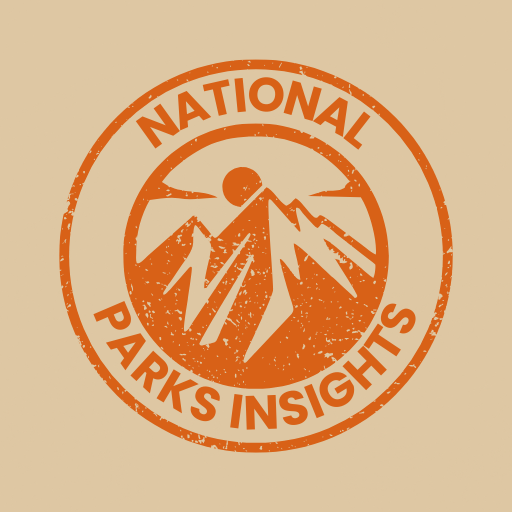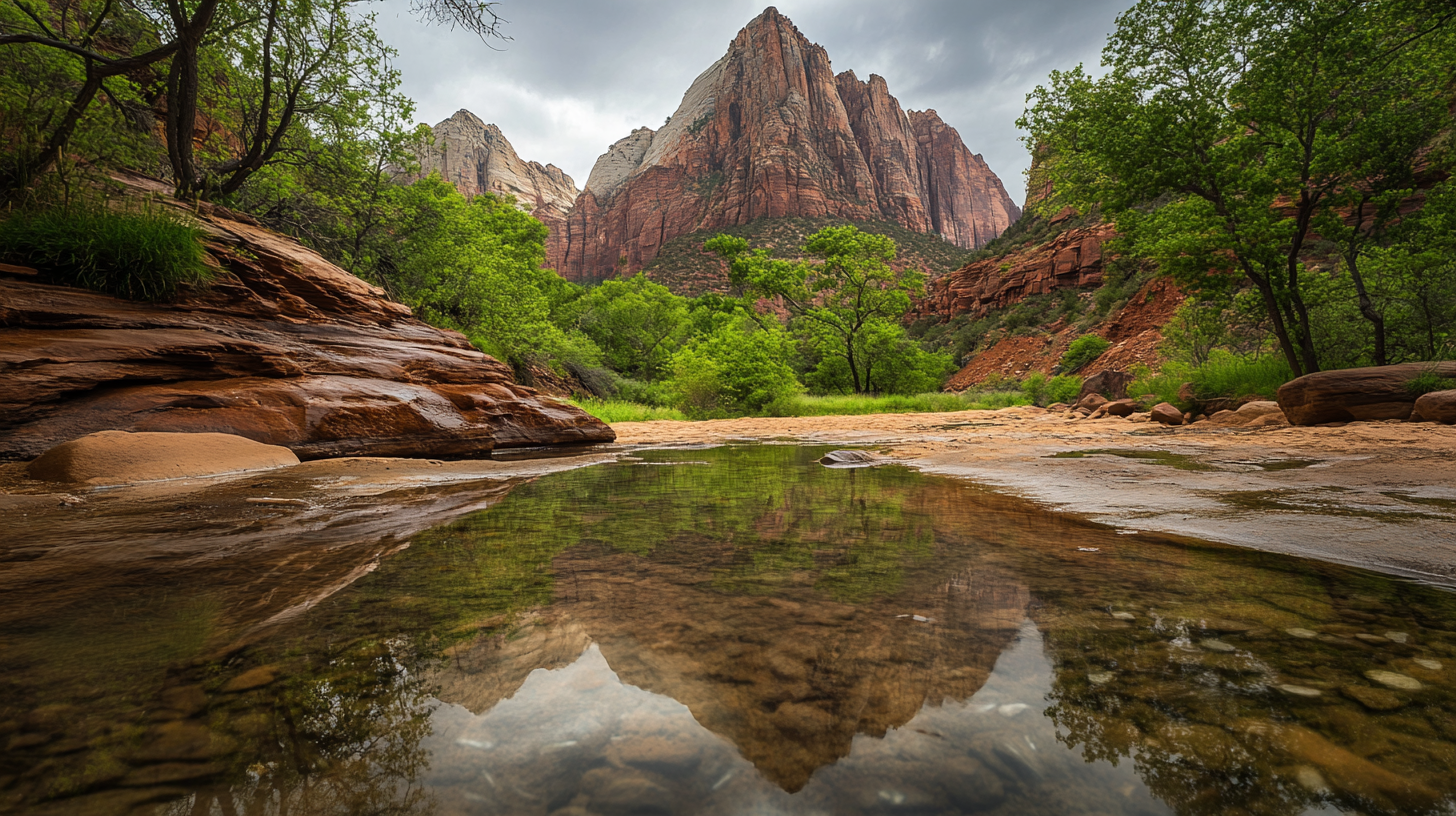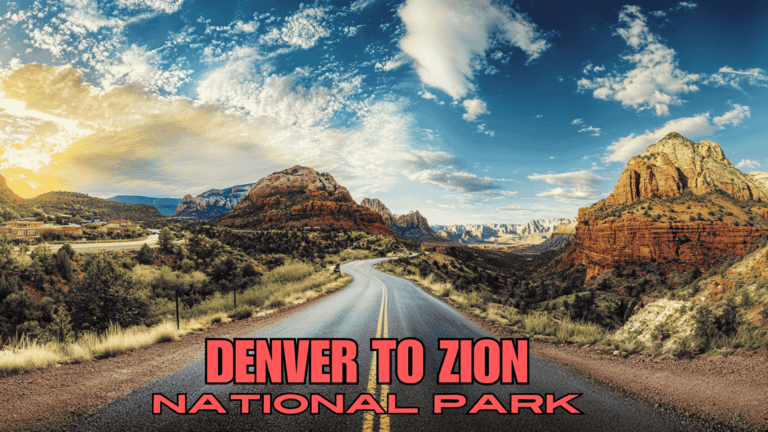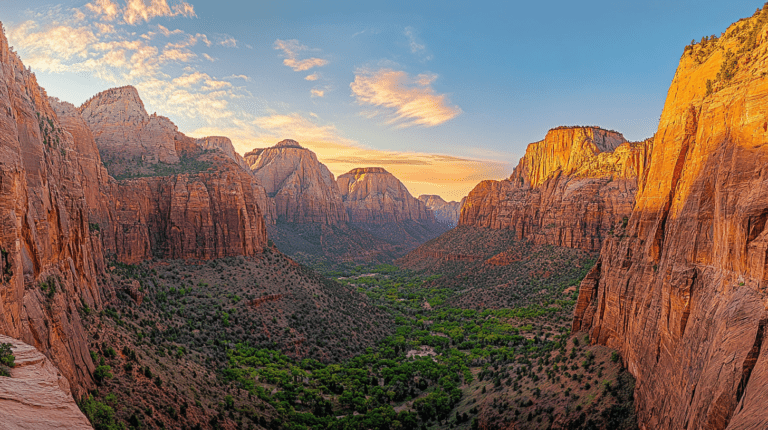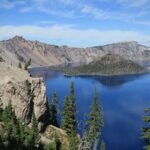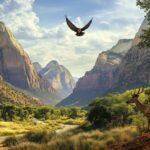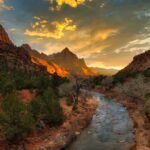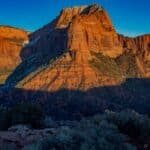Explore Zion National Park Caves
Imagine standing at the entrance of a hidden cave, feeling the cool air rush out. The thrill of the unknown draws you in, leading you deeper into a world of wonder. This is the magic of Zion National Park, where many visit to see the tall sandstone cliffs. But few know about the hidden caves beneath.
Start a journey through Zion’s underground, where every turn surprises you. From the tough parts of Pine Creek Slot Canyon to the calm beauty of Weeping Rock, Zion has caves for all adventurers. Whether you’re an expert or just curious, Zion’s caves offer an experience you won’t forget.
Unlock the wonders of Zion National Park with a personalized experience! Book one of the private tours of Zion National Park for an unforgettable adventure tailored just for you.
Zion has over 100 miles of trails and many canyoneering routes. Get your hiking permits and join a guided canyoneering tour to discover Zion’s underground secrets. You’ll climb through narrow spots, swim in icy waters, and rappel down steep cliffs. This is how you explore the hidden slot canyons and caves in the park.
Key Takeaways:
- Zion National Park has many hidden caves and slot canyons to explore.
- Canyoneering and caving tours are a fun way to see Zion’s underground.
- Hikers can get permits to visit remote parts of the park and find hidden spots.
- Zion’s caves offer a mix of challenges and beauty, from tough to calm.
- With the right preparation and guide, exploring Zion’s caves can be safe and memorable.
Click here to check the Hotels near Zion National Park
Discover the Magic of Zion Canyon
When you enter Zion National Park, the stunning beauty of Zion Canyon greets you. This wonder, shaped by the Virgin River over millions of years, is the park’s core. The canyon’s cliffs soar up to 2,625 feet, making it a breathtaking sight and an adventure spot.
Zion Canyon stretches 15 miles and is perfect for those who love nature and adventure. You can explore zion national park caves, tackle the famous zion narrows hike, or just take in the beauty of the zion canyons. There’s something for everyone here.
Hiking is a great way to see Zion Canyon. The Narrows lets you walk through the Virgin River, with walls that seem to meet the sky. For easier trails, try the Riverside Walk to see the canyon’s beauty without the hard work.
“Zion National Park is a mecca for climbers, hikers, bikers, canyoneers, and adventure enthusiasts, offering a lifetime of exploration and discovery.”
Here are some ways to dive into Zion Canyon:
- Rent a bike and ride the scenic Zion Canyon Road, closed to cars from March to November, for a close-up of nature.
- Go on a guided climbing tour at Lambs Knoll to climb the canyon walls and feel the thrill of exploring vertically.
- Try canyoneering, rappelling through slot canyons and finding hidden spots in the park’s remote areas.
Exploring Zion Canyon lets you see nature’s power up close. With every step, you’ll find new wonders and make memories that will stay with you forever.
Planning your trip to Zion National Park? Discover the closest airports and the best travel routes by checking out the Zion National Park airport guide for a smooth start to your journey.
Top 10 Caves to Explore in Zion National Park
Zion National Park is full of caves and slot canyons, each offering a unique adventure. With over two dozen options, you’ll always find something new to explore. Here are some top caves and slot canyons to see when you visit Zion.
Mammoth Cave: A Must-Visit Lava Tube
Mammoth Cave, near Zion National Park, is Utah’s longest lava tube, over 2,100 feet long. It was made by ancient volcanoes and shows us the Earth’s past. Walking through its dark tunnels, you’ll see amazing rock formations and feel the thrill of discovery.
Peekaboo Slot Canyon: Stunning Red Rock Formations
Peekaboo Slot Canyon, also known as Red Canyon, is a 5.9-mile hike that takes about 3 hours. It’s less crowded than other places and has beautiful red rock walls and narrow paths. The canyon’s colors and quiet nature make it a top choice for those looking for a peaceful hike.
Belly of the Dragon: A Unique Hiking Experience
Belly of the Dragon is a short drive from Zion and is a man-made tunnel turned popular hike. It’s a cool place to escape the heat and see something different. Walking through, you’ll see how light filters in, creating a magical atmosphere.
The Narrows: Zion’s Most Famous Slot Canyon
The Narrows is a challenging but rewarding hike in Zion. It’s a 16-mile trek through a narrow canyon with water up to your waist. It takes about 7 hours and 30 minutes, but the views and feeling of achievement are worth it. Make sure you’re prepared and check the weather before you go.
Weeping Rock: A Short Hike to a Serene Alcove
Weeping Rock is a short, easy hike for a peaceful break. It’s a 0.4-mile round trip that takes 30 minutes to complete. You’ll find a beautiful rock alcove with water flowing from the sandstone. It’s perfect for a picnic or a quiet moment.
Keyhole Canyon: A Technical Adventure for Thrill-Seekers
Keyhole Canyon is for experienced hikers and canyoneers. It’s a 2.5-mile hike that needs rappelling gear, a wetsuit, a helmet, and a headlamp. You’ll go through narrow passages, cold water, and tough obstacles. It takes 3-4 hours and is an unforgettable experience. Always put safety first and don’t try it without the right gear and experience.
Zion National Park’s caves and slot canyons show nature’s power and beauty. They let visitors explore hidden wonders and challenge themselves safely.
Formation of Zion National Park Caves
The caves in Zion National Park show the power of nature and geological processes. These caves have been shaped over millions of years. As you visit the zion national park caves, you’ll see amazing formations and learn about the park’s history.
The Role of Water in Cave Creation
Water is key to making the caves in Zion National Park. Over millions of years, water flowing through the sandstone has carved out the zion canyons and caves. The North Fork of the Virgin River has washed away thousands of feet of rock, showing erosion’s power.
Flash floods in the park can make the Virgin River’s flow jump from 200 to 4,500 cubic feet per second. These floods help shape the zion national park caves.
Physical and Chemical Weathering Processes
The caves formed through physical and chemical weathering. Physical weathering happens when water gets into rock cracks, making them bigger over time. The park is losing about 1,300 feet of land each million years due to erosion.
Chemical weathering is also important. Rain mixed with carbon dioxide forms a weak acid that breaks down the rock’s calcite. This creates caves in the zion canyons.
The geology of Zion and Kolob canyons area represents 150 million years of sedimentation, with uplift starting 13 million years ago.
When you see the caves in Zion National Park, think about the millions of years of work by nature. They show the power of water and how physical and chemical weathering work together.
Click here to check the Hotels near Zion National Park
Self-Guided Caving in Zion National Park
Exploring Zion National Park’s caves on your own is an exciting way to see its hidden beauty. The park has many caves and canyons perfect for nature lovers. It doesn’t matter if you’re new to caving or have done it before. Zion has caves and tours for everyone.
Before you start your caving trip, make sure you’re ready. The park is open all day, every day, all year. But, you’ll need a permit for some caves. You can buy a weekly pass at the entrance or use your annual or lifetime pass.
It’s safer to cave with a group of 3-10 people. This way, you’ll have help if something unexpected happens. Don’t forget to bring extra lights, good shoes, and gloves for your hands.
One great thing about caving in Zion is finding hidden spots. While many go to The Narrows and The Subway, there are many other caves to discover. These places let you see Zion’s beauty up close and uncover its secrets.
Always tell someone your plans and when you’ll be back. This keeps someone informed about your location and can help in case of an emergency.
Try to stay in the park for a few days to fully enjoy your caving trip. Zion has places to stay like campgrounds and lodges. Or, you could rent a campervan to move around freely and enjoy the park’s beauty.
For an immersive experience, nothing beats camping in Zion! Learn more about the top spots for camping in Zion National Park to enjoy nature at its finest.
When you’re caving, follow the rules and Leave No Trace principles. Respect closed areas, don’t trespass, and keep your impact on nature small. Being careful helps protect these caves for others in the future.
Click here to know more about National Parks
Guidelines for Responsible Cave Exploration
When you go on a zion adventure tour to see the amazing zion national park caves, it’s key to follow safety rules. These rules protect you and keep the caves safe for everyone. By being careful, you can enjoy Zion’s caves without harming the environment.
Safety Precautions and Weather Considerations
Before you enter Zion’s caves and slot canyons, put safety first. Always look at the weather forecast and watch out for flash floods from early July to mid-April. Heavy rain can make rocks fall, making it hard to walk, and summer can get very hot, leading to dehydration. Bring at least one liter of water per person and wear shoes with good grip.
Leave No Trace Principles
To keep Zion’s caves beautiful for the future, follow Leave No Trace rules:
- Stay on marked paths and don’t touch the cave formations.
- Avoid breaking off any cave part, as it harms the natural growth.
- Take out all trash, including food and packaging.
- Don’t leave any marks or graffiti on the cave walls or around them.
Take only pictures, leave only footprints, and kill only time.
Respecting Area Closures and Regulations
The National Park Service might close some areas to protect them or keep visitors safe. Always listen to these closures and follow the rules. Some places might need permits before you can enter, so check and get them if needed. By doing this, you help keep Zion’s caves beautiful for you and others.
The Role of the National Park Service in Protecting Caves
The National Park Service (NPS) is key in keeping Zion National Park’s caves safe. Since 1916, it has worked to protect America’s natural treasures. Today, it looks after 431 units over 85 million acres, including Zion’s caves.
The NPS sets strict rules and needs permits for some activities in the park. These permits help protect the caves by controlling how many people visit. This way, the impact on these delicate places is kept low.
The NPS teaches visitors how to caving right. It promotes Leave No Trace and following park rules. This helps keep the park’s nature safe for the future.
“The National Park Service’s mission is to preserve unimpaired the natural and cultural resources and values of the National Park System for the enjoyment, education, and inspiration of this and future generations.” – National Park Service
The NPS also does important research and monitoring in Zion National Park caves. This helps make better decisions and tackle threats like climate change and invasive species.
Thanks to the NPS, people from all over can visit Zion’s caves safely. By protecting these places, we make sure future generations can enjoy their beauty and mystery too.
Zion National Park Caves: A Lifetime of Adventure
Zion National Park covers 229 square miles and is a dream spot for those who love adventure and nature. It boasts towering cliffs, lush valleys, and hidden caves. The park is alive with over 1,000 plant species, 289 bird species, 75 mammals, and 32 reptiles.
Exploring Zion’s caves and slot canyons is an exciting way to see its wonders. From popular trails to hidden spots, there’s always something new. Join a zion adventure tour to see the stunning beauty of Zion’s underground.
The memories you create while exploring Zion National Park’s caves will last a lifetime, inspiring you to return time and time again to this remarkable sanctuary.
Zion welcomes both seasoned cavers and beginners. Tours like the Cave Lakes Canyon Horse Trail Riding and Via Ferrata and Rappelling tour are great for beginners. For a deeper experience, try Luxury Glamping at Cave Lakes Canyon to spend the night under the stars.
Walking through Zion’s caves takes you to a unique world. The park’s rocks tell a story of millions of years of change. You’ll see the red rock beauty of Peekaboo Slot Canyon and the calm of Weeping Rock.
Here are some tips for a safe and fun zion underground adventure:
- Always check the weather and area closures before you go.
- Make sure you have the right gear, like strong shoes, lots of water, and a good light.
- Keep the park clean by following Leave No Trace principles.
- Think about joining a guided tour to learn from experts and see special places.
As you explore Zion’s caves, enjoy the rare beauty around you. The National Park Service works hard to protect these places. This way, future visitors can also experience Zion’s underground magic.
Start an unforgettable journey through Zion National Park’s caves. With every step, you’ll dive into a world of wonder, adventure, and memories that will last forever.
Exploring the Inner Chambers of Zion’s Sandstone Walls
Deep in Zion National Park, a magical world awaits the brave. The park has slot canyons and caves that offer a surreal experience. These hidden places are perfect for adventurers wanting to see the inner beauty of nature.
Pine Creek Slot Canyon: A Surreal Experience
Pine Creek Slot Canyon is a mesmerizing Zion National Park cave. Going down into its narrow chambers feels like entering a different world. The cool, dark pools reflect light on the walls, creating a magical atmosphere.
This canyon shows the hidden beauty of Zion’s sandstone walls. Its unique formations and colors make the landscape surreal. It feels like stepping into another world.
Technical Challenges and Breathtaking Views
Exploring Zion’s slot canyons and caves is not easy. Many, like Pine Creek Slot Canyon, need technical skills and special gear. Zion canyoneering tours are great for those wanting expert guidance.
Despite the challenges, the rewards are huge. You’ll rappel down walls, swim in icy pools, and climb over boulders. These actions lead to stunning views that few get to see. Feeling accomplished after a slot canyon trip is unmatched, making it all worth it.
The beauty of Zion’s slot canyons and caves shows nature’s power and the park’s landscape diversity. Whether you’re an expert or just curious, these hidden spots will leave a mark on your heart and mind.
Zion National Park: A Mecca for Adventure Enthusiasts
Zion National Park is famous for its stunning landscapes and varied terrain. It’s a dream spot for those who love adventure and nature. With its canyons, trails, and hidden spots, there’s a lot to do here. Activities range from canyoneering and hiking to rock climbing and zion adventure tours.
Canyoneering is a big hit in Zion National Park. It’s great for both new and seasoned canyoneers. You can pick from many canyons, like Mystery Canyon for rappelling and hiking, or The Narrows for a challenge of your choice.
Canyoneering in Zion National Park is an unforgettable experience. It lets you dive into the park’s beauty, test your limits, and find hidden spots.
Here are some tips for planning your canyoneering trip:
- Check your skill level and pick a route that fits you
- Consider taking instructional courses or guided trips to learn more and stay safe
- Make sure you have the right gear, like good shoes, navigation tools, ropes, harness, helmet, and clothes that keep you dry
- Get the permits you need for technical adventures
Zion National Park also has many hiking trails that show off its beauty. You can tackle the Subway hike, a 10-mile challenge for the brave, or try Angel’s Landing and Observation Point trails. These hikes let you see amazing views, unique rocks, and the beauty of nature.
Click here to check the Hotels near Zion National Park
Hiking: The Best Way to Experience Zion’s Wonders
Zion National Park welcomes over 4 million visitors each year. It offers hiking trails for everyone, from easy walks for families to tough backcountry hikes. Hiking is the top way to see the park’s stunning views and hidden spots. You can find trails for breathtaking sights, unique rocks, or to get away from the crowds.
Ready to explore Zion’s most breathtaking trails? Get all the details on the best routes by visiting our guide to hiking trails in Zion National Park.
The Narrows hike is a must-do, taking you through a narrow canyon carved by the Virgin River. It’s a 10-mile journey that can be done in a day or as an overnight trip. You’ll see towering walls and sparkling pools. Just be ready for wet feet and some tough parts.
The Subway: Zion’s Best Hike
The Subway hike is a unique adventure, covering 7 miles round trip through a tunnel-like canyon. It’s a tough hike with slippery rocks, cold water, and some tricky spots. But the Subway’s beauty, with its waterfalls, green pools, and sandstone walls, is unmatched. It’s perfect for photographers and adventurers.
Before you head out, make sure to check the Zion National Park entrance fee information to plan your visit accordingly.
Angel’s Landing: A Thrilling Ascent
Angel’s Landing is for those seeking a thrilling hike with amazing views. This 5.5-mile trail goes up 1,500 feet to a ridge, offering wide views of Zion Canyon. The last half-mile is a steep, exposed path with chains, testing your courage and strength. The views from the top are incredible, making the effort worth it.
Observation Point: Stunning Views Without the Crowds
Observation Point is a great choice if you want to avoid the crowds at Angel’s Landing. This 8-mile hike goes up 2,000 feet to a high spot above Zion Canyon, giving you wider views than Angel’s Landing. The trail goes through Echo Canyon, past big cliffs and old rocks, ending at a breathtaking viewpoint. It’s a tough hike but offers peace and amazing views.
Discovering Hidden Gems in Zion’s Remote Corners
Zion National Park’s popular trails draw millions each year. But its remote corners hold hidden gems. These spots let you see Zion’s beauty and peace away from crowds. Explore the Northgate Peaks or the Hop Valley Trail to the huge Kolob Arch, the world’s second-biggest rock arch.
For a true adventure, try a zion canyoneering tour or a zion adventure tour. These tours take you deep into Zion, showing you hidden caves and slot canyons. With expert guides, you can safely explore and learn about Zion’s unique nature and history.
Exploring Zion’s remote corners means leaving behind the daily rush. You’ll find peace in the stunning landscapes. Whether hiking the tough Kolob Arch trail or walking the easy Timber Creek Overlook Trail, you’ll see amazing views. So, bring your adventure spirit and find Zion’s hidden treasures.
Latest Updates
New Permit System for Zion National Park Caves and Canyons
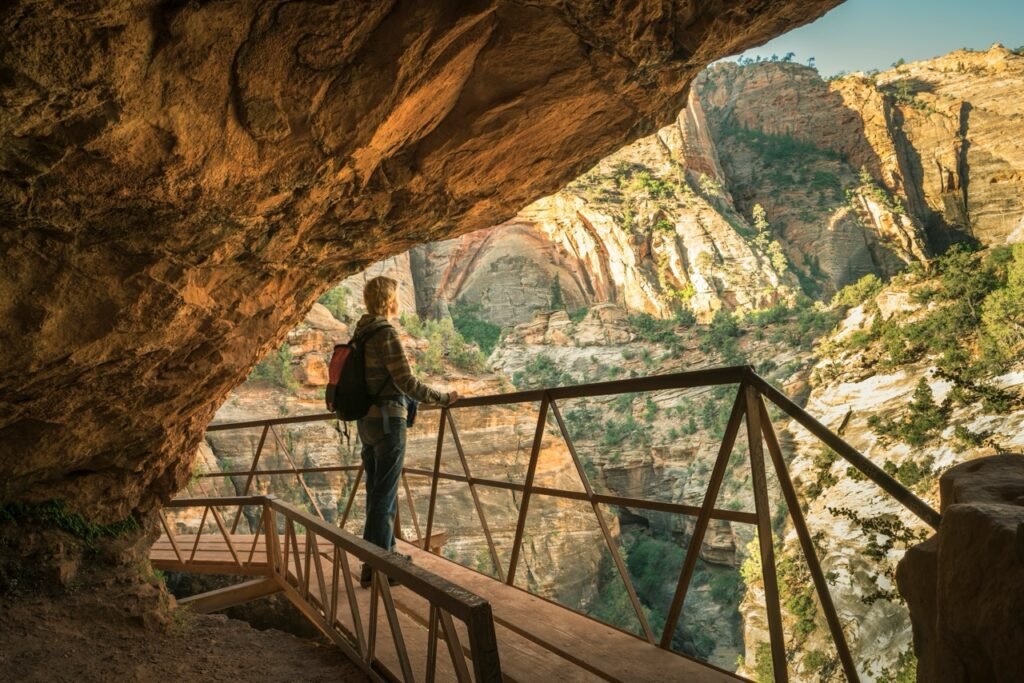
Zion National Park continues to captivate visitors with its stunning landscapes and hidden wonders, including its fascinating cave systems. The National Park Service has recently implemented a new permit system for certain popular canyoneering routes, including those that pass through some of Zion’s most intriguing cave formations.
This system aims to balance visitor access with environmental protection, ensuring that these delicate ecosystems remain preserved for future generations.
Exciting Discovery: New Cave System in Zion National Park
In an exciting development for cave enthusiasts, a team of geologists has discovered a previously unknown cave system in the park’s less-explored western region. While details are still emerging, preliminary reports suggest that this new cave network may offer unique geological features not found in other Zion National Park caves.
Climate Change Impact on Zion National Park Caves

Climate change continues to impact Zion’s cave ecosystems. Recent studies have shown shifts in cave-dwelling species populations, highlighting the delicate balance of these underground habitats.
Park officials are closely monitoring these changes and adapting management strategies accordingly.
Educational Initiative: Zion National Park Caves Conservation Program
The park has also launched a new educational program focused on cave conservation. This initiative aims to raise awareness about the importance of Zion National Park caves and teach visitors about responsible exploration techniques.
The program includes interactive exhibits at the visitor center and guided “mini caving” experiences suitable for families.
Updated Safety Guidelines for Exploring Zion National Park Caves
For those planning to explore Zion National Park caves, it’s worth noting that the park has updated its safety guidelines. These new recommendations emphasize the importance of proper gear, including helmets with chin straps and backup light sources.
Visitors are also encouraged to check in with park rangers before embarking on any caving adventures.
Community Involvement: “Adopt-a-Cave” Program in Zion National Park
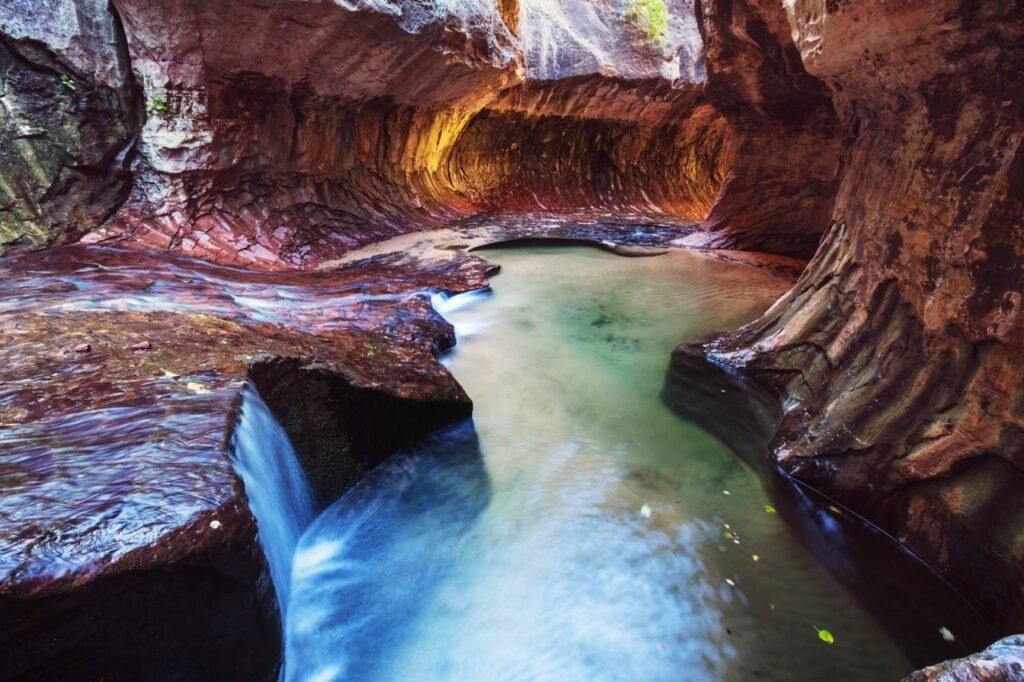
Lastly, a local conservation group has partnered with the park to launch a “Adopt-a-Cave” program. This initiative allows volunteers to participate in cave monitoring and cleanup efforts, providing a hands-on way for enthusiasts to contribute to the preservation of Zion National Park caves.
These updates reflect the ongoing efforts to balance exploration, education, and conservation in Zion National Park’s cave systems.
As interest in these hidden wonders continues to grow, staying informed about the latest developments ensures a safe, responsible, and awe-inspiring caving experience.
Latest Updates
As of October 2024, Zion National Park continues to captivate visitors with its stunning landscapes and hidden wonders, including its fascinating cave systems. Recent developments have brought exciting changes and discoveries related to Zion National Park caves[1].
The National Park Service has implemented a new permit system for certain popular canyoneering routes, including those that pass through some of Zion’s most intriguing cave formations. This system aims to balance visitor access with environmental protection, ensuring that these delicate ecosystems remain preserved for future generations[1].
In an exciting development for cave enthusiasts, a team of geologists has discovered a previously unknown cave system in the park’s less-explored western region. While details are still emerging, preliminary reports suggest that this new cave network may offer unique geological features not found in other Zion National Park caves[1].
Climate change continues to impact Zion’s cave ecosystems. Recent studies have shown shifts in cave-dwelling species populations, highlighting the delicate balance of these underground habitats. Park officials are closely monitoring these changes and adapting management strategies accordingly[1].
The park has also launched a new educational program focused on cave conservation. This initiative aims to raise awareness about the importance of Zion National Park caves and teach visitors about responsible exploration techniques. The program includes interactive exhibits at the visitor center and guided “mini caving” experiences suitable for families[1].
For those planning to explore Zion National Park caves, it’s worth noting that the park has updated its safety guidelines. These new recommendations emphasize the importance of proper gear, including helmets with chin straps and backup light sources. Visitors are also encouraged to check in with park rangers before embarking on any caving adventures[1].
Lastly, a local conservation group has partnered with the park to launch an “Adopt-a-Cave” program. This initiative allows volunteers to participate in cave monitoring and cleanup efforts, providing a hands-on way for enthusiasts to contribute to the preservation of Zion National Park caves[1].
These updates reflect the ongoing efforts to balance exploration, education, and conservation in Zion National Park’s cave systems. As interest in these hidden wonders continues to grow, staying informed about the latest developments ensures a safe, responsible, and awe-inspiring caving experience[1].
Citations: [1] https://nationalparksinsights.com/explore-zion-national-park-caves/ [2] https://nationalparksinsights.com/explore-zion-national-park-caves/[3] http://npshistory.com/morningreport/incidents/zion.htm [4] https://www.nps.gov/zion/learn/news/zion-2024-campground-and-wilderness-permit-changes.htm
FAQ
What types of caves can I explore in Zion National Park?
Zion National Park has many caves and slot canyons to explore. You can visit Mammoth Cave, Peekaboo Slot Canyon, and Belly of the Dragon. The Narrows, Weeping Rock, Keyhole Canyon, and Pine Creek Slot Canyon are also great spots. Each place has its own unique features and challenges.
Do I need a permit to explore Zion National Park Caves?
Yes, some caves in Zion National Park need permits for caving and canyoneering. Always check with the National Park Service for the latest rules. Make sure to get the permits before you start your adventure.
What equipment do I need for caving in Zion National Park?
For caving in Zion, you’ll need helmets, headlamps or torches, and good footwear. Gloves are also a must for protection. Some caves require technical gear like ropes, harnesses, and rappelling equipment.
Are there guided caving tours available in Zion National Park?
Yes, there are guided tours for caving and canyoneering in Zion National Park. These tours come with experienced guides, the right equipment, and a safe way to see the park’s stunning caves and slot canyons.
Click here for amazing offers on Guided Tours fulfilled by Expedia.com
What safety precautions should I take when exploring caves in Zion National Park?
Always watch the weather when caving in Zion, as flash floods can happen from July to mid-September. Stay on marked paths and wear safety gear. Tell someone where you’re going and when you’ll be back. Bring water and snacks, and be ready for temperature changes in the caves.
How were the caves in Zion National Park formed?
The caves in Zion were made by water working on the sandstone. Water gets into cracks and makes them bigger over time. Rainwater mixed with carbon dioxide creates a weak acid that breaks down the rock, making caves.
Are there any famous hikes in Zion National Park that involve caves or slot canyons?
Yes, some top hikes in Zion include caves and slot canyons. The Subway is a 9.1-mile hike through a unique slot canyon. The Narrows lets you walk through a narrow canyon by wading in the Virgin River. Keyhole Canyon is a short hike that requires rappelling and swimming in cold water.
What should I do to help protect the caves in Zion National Park?
To protect Zion’s caves, follow Leave No Trace principles. Take all trash with you, don’t leave any marks, and don’t touch cave formations or wildlife. Always follow park rules and closures to keep these places safe for everyone.
